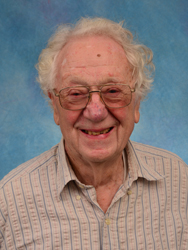Oliver Smithies, PhD dies at age 91
Oliver Smithies, PhD, the Weatherspoon Eminent Distinguished Professor of Pathology and Laboratory Medicine at the UNC School of Medicine, has died at age 91. He is survived by his wife, Nobuyo Madea, PhD, Robert H. Wagner Distinguished Professor of Pathology and Laboratory Medicine.

Smithies was the first full-time faculty member at UNC Chapel Hill to win a Nobel Prize. Smithies received the prize for his development of a technique called homologous recombination that makes it possible to introduce targeted genetic modifications to cells. Smithies shared the 2007 prize with Mario Capecchi of the University of Utah's Howard Hughes Medical Institute and Sir Martin Evans of the United Kingdom.
Smithies' work made possible the creation of "knockout mice," the use of which has contributed significantly to our understanding of how individual genes work. Knockout mice have also been used to study and model varieties of cancer, obesity, heart diseases and other diseases. Smithies' lab at UNC created the first animal model of cystic fibrosis in 1992. This work was just one of Smithies' many notable scientific achievements. Much earlier in his career, while working as a research scientist at the Connaught Medical Research Laboratory in Toronto, Canada, Smithies invented a process called starch gel electrophoresis, the immediate forerunner of polyacrylamide gel electrophoresis, a method still in use today.
Smithies and his fraternal twin brother Roger were born June 23rd, 1925, in Halifax, England. Smithies' childhood was happy but uneventful, except for a bout with rheumatic fever at age seven that left him with a trivial heart murmur. At the time, however, the condition was regarded as serious enough that he was not permitted to play sports until he was a teenager.
Smithies filled his hours by reading, a pastime encouraged by his mother who was an English teacher at the local community college, and tinkering, building telescopes and radio sets, and helping his father, an insurance salesman, maintain the family car.
In 1943 he received a scholarship to Oxford University where he briefly studied medicine before changing the concentration of his studies to physiology. He received his bachelor's degree in physiology in 1946, and went on to receive his master's degree and doctorate in biochemistry from Oxford in 1951.
Smithies performed post-doctoral work at the University of Wisconsin before going to work at Connaught Medical Research Laboratory where he worked from 1952 until 1960. It was here that Smithies developed his starch gel electrophoresis technique. The high-resolutions gels that Smithies was able to create with his new method allowed researchers to study blood proteins much more effectively. Before this, scientists thought that a molecule of blood contained five different proteins. Smithies found 25 proteins in all and also determined that all of us have very different mixtures of proteins in our blood.
Smithies returned to the University of Wisconsin in 1960, where he was one of the first scientists to physically separate a gene from the rest of the DNA of the human genome. In 1982, Smithies recorded in his notebook an experimental schema to modify specific genes. The method for targeted modifications in genes ("gene engineering") that resulted from these experiments has become an indispensable part of the toolbox for experimental genetics, allowing researchers to understand the function of specific genes in physiology and pathology, and playing a key role in the development of new treatments for a variety of diseases.
Smithies and his wife, Nobuyo Maeda, joined the faculty of UNC in 1988. His research continued to use gene targeting to create animal models in order to study human diseases in order to better understand their cause and progression, and to help develop new modes of treatment. His most recent research has focused on hypertension and kidney disease. Until his death, Smithies was still at the lab bench seven days a week, pursuing his research with the same enthusiasm that has animated his scientific career for more than 70 years. In addition to his work, Smithies was also an avid pilot and is especially fond of gliding.
Oliver Smithies made many remarkable discoveries that have had, and will continue to have, beneficial effects on many scientific and medical disciplines.
Selected Awards:
- Member of the U.S. National Academy of Sciences, 1971
- Fellow of the American Academy of Arts and Sciences, 1978
- Fellow of the American Association for the Advancement of Science, 1986
- Gardiner Foundation International Award, 1990 and 1993
- Alfred P. Sloan Award from the General Motors Foundations, 1994
- Ciba Award for Hypertension Research from the American Heart Association, 1996
- The Bristol Myers Squibb Award, 1997
- American Association of Medical Colleges' Award for Distinguished Research (with Mario Capecchi), 1998
- Foreign Member of the Royal Society,1998
- International Okamoto Award from the Japan Vascular Disease Research Foundation, 2000
- Albert Lasker Award for Basic Medical Research (with Martin Evans and Mario Capecchi), 2001
- O. Max Gardner Award, the highest award for faculty in the University of North Carolina system, 2002
- the Massry Prize, from the Meira and Shaul G. Massry Foundation (with Mario Capecchi), 2002
- Member of the U.S. Institute of Medicine, 2003
- the Wolf Prize in Medicine (with Mario Capecchi and Ralph L. Brinster), 2003
- Thomas Hunt Morgan Medal from the Genetics Society of America, 2007
- Nobel Prize in Physiology and Medicine, 2007
- Gold Medal from the American Institute of Chemists, 2009
- Honorary Degree, Doctor of Science, Oxford University, 2011
- Charter Fellow of the National Academy of Inventors, 2013
- Faculty Service Award, UNC General Alumni Association, 2014
Smithies in his own words:
2001 Commentary article from Nature that talks about scientific tool making and details several of the experiences over the course of his career
Autobiographical remarks from 2007
2015 interview with PLOS Genetics